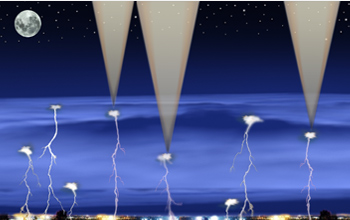News Release 08-205
Small Satellite Takes on Large Thunderstorms
'Firefly' CubeSat Mission to Study Lightning's Link to Terrestrial Gamma Ray Flashes
November 17, 2008
This material is available primarily for archival purposes. Telephone numbers or other contact information may be out of date; please see current contact information at media contacts.
Firefly, it's called, this new small satellite mission sponsored by the National Science Foundation (NSF). It's designed to help solve the mystery of the most powerful natural particle accelerator in Earth's atmosphere: TGFs, or terrestrial gamma-ray flashes. TGFs likely result from thunderstorms.
The mission is the second project under the new NSF CubeSat program. A CubeSat satellite, about the size of a loaf of bread, consists of three cubes attached end to end in a rectangular shape.
The Firefly team is a collaboration of scientists and students at the NASA Goddard Space Flight Center, Greenbelt, Md.; Siena College, Loudonville, N.Y.; Universities Space Research Association, Columbia, Md.; Hawk Institute for Space Science, Pocomoke City, Md.; and University of Maryland Eastern Shore, Princess Anne, Md.
"Integrating innovative and creative educational efforts with front-line research is what NSF is all about," said NSF Deputy Director Kathie L. Olsen. "The new CubeSat program uses the transformational technology of CubeSats to do just that. The Firefly mission is a terrific example of a program that will pursue scientific discovery, while providing unique and inspiring educational opportunities."
TGFs are short, powerful bursts of gamma rays emitted into space from Earth's upper atmosphere. The gamma rays are thought to be emitted by electrons traveling at or near the speed of light when they are slowed down by interaction with atoms in the upper atmosphere. These events may occur much more often than realized and may be associated with a significant fraction of the roughly 60 lightning strokes per second that occur worldwide. They could have a large effect on the upper atmosphere and near-Earth space, scientists say.
Build-up of electric charge at the tops of thunder clouds from lightning discharges can create a large electric field between the tops of clouds and the ionosphere, the outer layer of Earth's atmosphere. But how this might lead to the generation of these extremely energetic electrons is not well understood.
"This mission could provide the first direct evidence for the relationship between lightning and TGFs, and addresses an important research question in atmospheric electricity," said Anne-Marie Schmoltner, head of NSF's Atmospheric Sciences Division's Lower Atmosphere Research Section. "Identifying the source of terrestrial gamma ray flashes would be a great step toward fully understanding the physics behind lightning and its effect on the Earth's atmosphere." To accomplish these goals, Firefly will carry a gamma-ray detector along with a suite of instruments to detect lightning.
Students will be involved in all aspects of the project, from design and development, through fabrication and test, to mission operations and data analysis.
-NSF-
Media Contacts
Cheryl Dybas, NSF, (703) 292-7734, email: cdybas@nsf.gov
Rani Gran, NASA/GSFC, 301-286-2483, email: rani.c.gran@nasa.gov
The U.S. National Science Foundation propels the nation forward by advancing fundamental research in all fields of science and engineering. NSF supports research and people by providing facilities, instruments and funding to support their ingenuity and sustain the U.S. as a global leader in research and innovation. With a fiscal year 2023 budget of $9.5 billion, NSF funds reach all 50 states through grants to nearly 2,000 colleges, universities and institutions. Each year, NSF receives more than 40,000 competitive proposals and makes about 11,000 new awards. Those awards include support for cooperative research with industry, Arctic and Antarctic research and operations, and U.S. participation in international scientific efforts.
Connect with us online
NSF website: nsf.gov
NSF News: nsf.gov/news
For News Media: nsf.gov/news/newsroom
Statistics: nsf.gov/statistics/
Awards database: nsf.gov/awardsearch/
Follow us on social
Twitter: twitter.com/NSF
Facebook: facebook.com/US.NSF
Instagram: instagram.com/nsfgov



